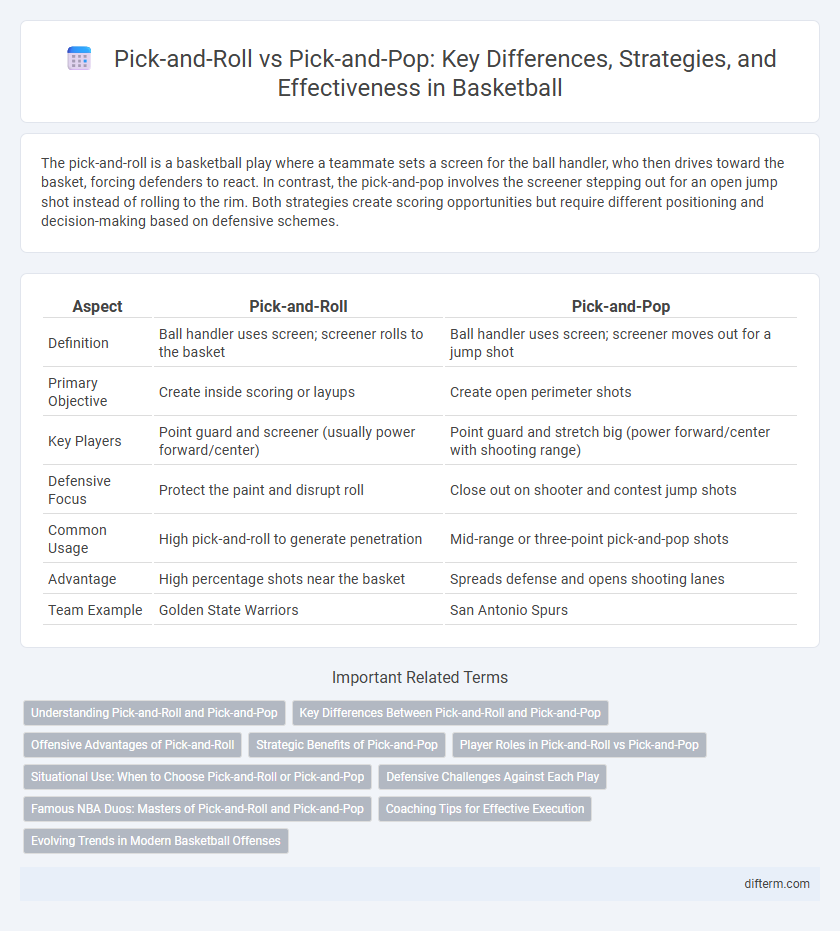The pick-and-roll is a basketball play where a teammate sets a screen for the ball handler, who then drives toward the basket, forcing defenders to react. In contrast, the pick-and-pop involves the screener stepping out for an open jump shot instead of rolling to the rim. Both strategies create scoring opportunities but require different positioning and decision-making based on defensive schemes.
Table of Comparison
| Aspect | Pick-and-Roll | Pick-and-Pop |
|---|---|---|
| Definition | Ball handler uses screen; screener rolls to the basket | Ball handler uses screen; screener moves out for a jump shot |
| Primary Objective | Create inside scoring or layups | Create open perimeter shots |
| Key Players | Point guard and screener (usually power forward/center) | Point guard and stretch big (power forward/center with shooting range) |
| Defensive Focus | Protect the paint and disrupt roll | Close out on shooter and contest jump shots |
| Common Usage | High pick-and-roll to generate penetration | Mid-range or three-point pick-and-pop shots |
| Advantage | High percentage shots near the basket | Spreads defense and opens shooting lanes |
| Team Example | Golden State Warriors | San Antonio Spurs |
Understanding Pick-and-Roll and Pick-and-Pop
Pick-and-roll and pick-and-pop are fundamental offensive strategies in basketball designed to create scoring opportunities through screen actions. The pick-and-roll involves a player setting a screen and then rolling toward the basket, aiming for a close-range shot or layup, leveraging defender mismatches and quick decision-making. In contrast, the pick-and-pop features the screener stepping out for a mid-range or three-point jump shot after the screen, emphasizing spatial spacing and shooting precision.
Key Differences Between Pick-and-Roll and Pick-and-Pop
The pick-and-roll involves a screen followed by the screener rolling towards the basket to create a scoring opportunity near the rim, emphasizing inside presence and physicality. In contrast, the pick-and-pop features the screener stepping away from the basket after the screen to take an open mid-range or three-point shot, leveraging shooting skills and spacing. Strategic use of each play depends on player strengths, defensive matchups, and floor spacing requirements.
Offensive Advantages of Pick-and-Roll
The pick-and-roll creates dynamic offensive opportunities by forcing the defense to choose between guarding the ball handler or the screener, often resulting in defensive mismatches and open driving lanes. Its versatility enables quick ball movement, leading to high-percentage shots and easy assists. This play increases team scoring efficiency by exploiting defensive rotations and generating multiple scoring options near the basket.
Strategic Benefits of Pick-and-Pop
The pick-and-pop strategy creates spacing advantages by allowing the screener to step out for an open jump shot, reducing defensive congestion near the basket. This tactic forces defenders to choose between contesting the outside shot or protecting the rim, increasing offensive options. Teams utilizing pick-and-pop effectively can exploit mismatches and improve scoring efficiency from beyond the arc.
Player Roles in Pick-and-Roll vs Pick-and-Pop
In pick-and-roll, the screener, often a strong, physical big man, sets a screen before rolling aggressively toward the basket to finish with a layup or dunk, while the ball-handler is typically a quick guard or forward skilled in penetrating and passing. In pick-and-pop, the screener, usually a versatile big with reliable mid-range or three-point shooting, sets a screen and then "pops" out to an open jump shot, providing spacing and scoring threats from beyond the paint. The ball-handler's role remains to initiate the play, read the defense, and either attack the rim or deliver a precise pass to the popping screener for an uncontested shot.
Situational Use: When to Choose Pick-and-Roll or Pick-and-Pop
Pick-and-roll is most effective in tight defensive situations where penetrating the lane creates scoring opportunities or forces help defense, allowing the roller to exploit gaps near the basket. Pick-and-pop is preferable when the screener is a proficient shooter, enabling floor spacing and open perimeter shots, especially against teams that aggressively hedge on screens. Coaches often choose pick-and-roll in transition or half-court pressure scenarios, while pick-and-pop suits lineups emphasizing outside shooting and avoiding congested paint defense.
Defensive Challenges Against Each Play
Defending the pick-and-roll requires defenders to communicate effectively and switch quickly to prevent open lanes and uncontested shots near the basket. The pick-and-pop demands defenders to extend their coverage to the perimeter, challenging shooters pulling away from the screen and creating difficulties in closing out without conceding outside shots. Both strategies force defensive rotations and situational awareness, testing team coordination in preventing high-percentage scoring opportunities.
Famous NBA Duos: Masters of Pick-and-Roll and Pick-and-Pop
Famous NBA duos like John Stockton and Karl Malone exemplify the pick-and-roll's effectiveness through precise screens and seamless scoring opportunities. In contrast, the pick-and-pop technique is mastered by pairs such as Steve Nash and Amar'e Stoudemire, where the screener often steps out for mid-range or three-point shots after setting the screen. These complementary strategies showcase how top NBA partnerships optimize court spacing and offensive versatility.
Coaching Tips for Effective Execution
To execute pick-and-roll effectively, coaches should emphasize precise timing, communication, and spacing between the ball handler and screener to create open lanes or mismatches. For pick-and-pop, training the screener to quickly pivot and space out for a reliable mid-range or three-point shot optimizes scoring opportunities. Reinforcing decision-making skills during drills helps players recognize when to roll to the basket or pop out based on defensive reactions and game situations.
Evolving Trends in Modern Basketball Offenses
Pick-and-roll and pick-and-pop remain fundamental strategies in modern basketball offenses, driving efficiency and spacing on the court. The pick-and-roll emphasizes ball-handler and screener coordination to penetrate defenses and create high-percentage shots near the rim. In contrast, the pick-and-pop leverages skilled big men capable of shooting from mid-range or beyond the arc, evolving into a primary scoring option that stretches opposing defenses and enhances perimeter spacing.
pick-and-roll vs pick-and-pop Infographic

 difterm.com
difterm.com